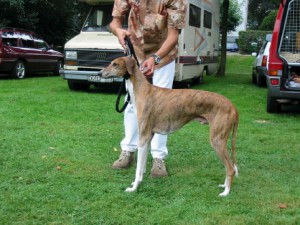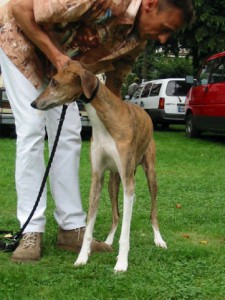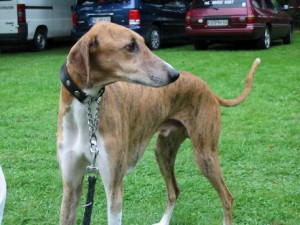Amanar
On 21st January 2004, I received sad news from Germany: Amanar, the grandsire of my dog, imported from Mali, was hit by a car and killed on the spot.
I discovered Amanar for myself several years ago, while browsing on Internet, searching for Azawakh breeders around the world. There was something about Amanar which attracted me, it seemed to me that among the African imports, he was unique, not just because I fell in love with his beautiful brindle colour and markings. He became my dream dog and I wished so much to have Amanar´s offspring. When I went to Germany to collect Amanar´s grandson several months later, I felt utterly happy, sure that my dream came true. And I asked Gabi, who had brought him to Europe from Africa, to tell me Amanar´s story:

Amanar´s story had started eight years before in Mali. At the beginning of 1996, another annual expedition of the ABIS organisation headed for the regions of Mali, Niger and Burkina Faso, its objective being not only to map the situation of the Azawakh in its natural habitat, take pictures, prepare statistics or bring new breeding stock to Europe, but also to provide aid to the Touaregs and other local people. ABIS financed a school for local children, provided basic grains for a local granary, and offered all kinds of support with the aim to contribute to the preservation of the local culture and way of life, devastated by repeated drought, and wars, insurrections and border conflicts at the beginning of the nineties. People going through such an ordeal have neither living conditions nor money to care for themselves, not to speak of their dogs. And both people and dogs surely deserve to be helped.
That year, Gabriele Meissen, a veterinary doctor and Azawakh breeder from Germany, joined the expedition. Among other activities, she participated in the vaccination of the local Azawakhs against rabies, which is a big problem in that part of the world. If there is any region where this lethal and highly contagious illness appears, local governments, instead of vaccination of animals, opt for a bit cheaper solution: with help of the army, dogs are killed as possible illness carriers. Azawakhs vaccinated by ABIS have bigger chances to survive such “cleansing“.
While passing through the Azawakh Valley, the expedition stopped to spend the night nearby a Touareg village called Anouzengrene. Hospitable local people invited the travellers to spend the night in the village. On the following morning, when Gabi was strolling through the village, she spotted a four-month old brindle puppy in a shallow hole under an acacia tree. At the very moment she knew she found what she wanted. The little dog was shy, he did not let unknown people touch him. The son of the puppy’s owner had to take the little dog out and hold it so that Gabi could touch him for the first time. But what next? How to obtain the puppy from its owner?
It is not easy to get an Azawakh from the Touaregs. If you find a dog you would like to have, it is impossible just to go straightforward to its owner offering money for the puppy. It would be too rude, an offence to the Touareg dignity. First, you have to explain your wishes to a dog’s owner’s friend. Then he, in a polite manner, conveys your wish to the dog’s owner. If he is willing to give the dog to you, a negotiation can start. Sometimes, it may take hours of tee-drinking and polite conversation. If you make a good impression and the dog’s owner comes to a conclusion that you can be considered a friend, he will give the dog to you as a gift. But of course, you cannot just say thank you and walk away: A gift is paid with a gift. Now it is your turn to honour your new Touareg friend with your presents.
It was a success. Gabi obtained the puppy and it became a real member of the expedition. The Touaregs called the little male Akchi, which is a denomination of a brindle male. Gabi gave him a beautiful name: Amanar. In the Tamashek, the language of the Touaregs, this means Orion. The puppy soon understood to whom it belonged, and little Amanar made friends with Gabi. They travelled through the Sahara desert, and the little Azawakh guarded the camp of his new friends against intruders. At nights, he cuddled in the sleeping bag, protecting Gabi from the cold of desert nights.

When Amanar arrived in Europe, he found himself in a totally unknown world. His paws, which until then knew only the desert sand, treaded carefully the asphalt pavement. However, Amanar soon adapted to such changes. He found home with Gabi´s friends and became a member of their pack. He grew up to become a nice male, and he followed the lure in coursing competitions with great passion. He sired three litters: in 1997, seven brindle puppies were born in the litter of N-Tombouktou´s. In 1999, he sired the “I“ litter of N'shat-ehad ´, and in the spring of 2003, Amanar sired a litter of Mouli de Garde Epee' of Mrs. Susannah Kent, living then in Great Britain. Amanar´s puppies thus became the first Azawakh puppies ever born in the United Kingdom. This country finally recognised the Azawakh as a pure breed in July 2003.
One day, in the annual Azawakh specialty in Germany, I dared to approach Amanar´s owner, asking him, if he could show me his lovely African and if I could take some pictures. Amanar was six years old then. I felt like a movie-star fan who was allowed to come near to her idol. What was Amanar like? A nice companion, little distrustful at first with the newcomers, but after some time, he became quite friendly.
Amanar lived with his people for eight years. He participated in coursing and racing events, he loved to go for long walks, and he also used to go biking with his owner to keep fit. On 15th January 2004, his owner took Amanar biking. About five hundred meters from their home, Amanar stopped abruptly, freeing himself from the collar, turned back and ran away. His owner though the dog returned home. He had never done anything like that. His owner made a dash for home, however, Amanar was not there.
An extended searching was organised immediately. Sighthound friends searched for Amanar on their behalf, and a notice was published in the local newspaper, information leaflets were put in the villages. During the following six days, Amanar was spotted several times; people called Amanar´s owner to tell him the dog was seen in a certain place. However, the owner arrived at the place always short time after the dog had disappeared again. Amanar was careful and shy, he did not let people come near him. It was freezing, snowing and raining alternately. Sighthound lovers were searching for Amanar twenty-four hours a day.

On Wednesday 21st January, the Amanar´s owner’s telephone rang again. Amanar was seen in a village approximately 25 km from his home. The dog was trying to find anything to eat in garbage around the houses. Immediately, several people started for the village and also Amanar´s owner arrived there. He had never got so close to Amanar and it seemed that Amanar´s story would have a happy ending. However, a car came running fast, hitting Amanar… The driver neither tried to break nor did he stop to see what he did. Amanar was dead on the spot. His story ended and he found his grave in the garden of his owners.
Who knows what went through his head then. Maybe his African blood, his love for freedom, came suddenly to life, urgent need to run through open spaces, be free, independent, forever. He is gone, a stranger in our world.
Amanar´s grandson sleeps peacefully on my sofa, enjoying soft cushions and the care of “his” people. The wild creature in him is sleeping now, but it can become awake at any moment. Independence, eternal longing for freedom stronger than anything else… It is amazing how similar we are… We learn from each other to perceive things long-hidden behind the mask of our civilised world.




